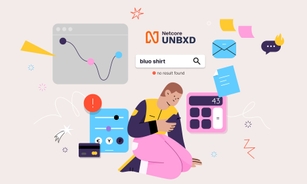- ProductsSearch and BrowseRecommendationsCustomer Engagement


Peter logged in to ‘Amynra,’ an ecommerce site. He wanted to grab some stuff for the impromptu bachelor party his friends had planned. Peter doesn’t have a great way of online shopping as he rarely shops online. For him, it was a maze of a plethora of products where he wanted to find his green, leafy, summery beach shorts! Indeed, it was a task.
So, he typed in ‘beach shorts’ and was flooded with ‘shorts’ of all types. Peter wasn’t ecstatic about the search results. He had to scroll deep and couldn’t find the ones he was searching for. He opted out.
Now, imagine how many ‘Peters’ visit your website daily. And what if they all kept opting out of your site every time? The most significant factor you should integrate into your site is showing relevant products based on the shopper’s intent and history. With so many websites and giants like Amazon and Flipkart in the market, there is no way you could find an escape with an average search engine. You need a solid relevancy platform and an equally well-knit ranking system.
What is a ‘Relevancy and Ranking’ system?
The relevancy settings are on point when shoppers find exactly what they are looking for. Unbxd, with its AI-powered system, justifies an efficient search engine with proper relevance and ranking settings to ensure shoppers don’t leave the site half-heartedly.
Ranking system
Ordering the most relevant products on the Product Listing Page increases its conversion rate. For example, A user typed a query on the search bar as 'shoes.' Such a generic request! Right? The search panel is flooded with results. Because there are ten to the power five results for shoes, you can't show all the results haphazardly to the shopper, making them jump from page to page! Instead, you should index and rank your product pages based on the shopper's behavior, first displaying the most relevant ones.
For example, If the shopper has a quirky sense of fashion and buys most of his products from Nike, the page displays 'Nike shoes' as the top result. This process of showing the most relevant results based on shoppers' affinity is called Ranking. Once you have ranked the products correctly, you can cleverly match your users' intentions and become the hero of their lives! Let's look at some live use cases where Ranking is required and how Unbxd can help.
Use case 1: Ranking the ‘Most Relevant’

I was searching for a book on Ghost Stories online on Amazon. The search results flooded my Product Listing Page with almost 1200 queries. This was so much to take in for me as a shopper that I closed all the tabs. Ultimately, I asked my niece for suggestions and bought the same book. If it keeps shoppers on their toes, displaying only the products that matter most is helpful.
The 'Most Relevant' products are ranked by identifying the shopper's intent and behavior using our AI engine.
Use case 2: Ranking based popularity quotient

We know how popular the 'iPhone X' became overnight on its launch date. People searched for and ordered it; thus, the phone model gathered huge sales. But, if you look at the other models from Apple, only some models are as famous as the iPhone X or 11. So, when a user searches for the "iPhone X," it is not advisable to showcase other iPhone models on the same page. This is because they are less popular on the charts. Therefore, displaying phones that rank high on the overall popularity charts only makes sense.
Imagine "Samsung Galaxy S10" is being searched by most shoppers on your site and ranked as the most popular phone product. So, when shoppers search for iPhone X, the Samsung Galaxy S10 is also displayed on the first page of search results after iPhone X. In this way, if the person is in the market for an iPhone, he can get a sneak peek at what else is topping the charts or performing exceptionally. So, make sure you boost the brand enough if it is selling like hotcakes and selling well. To boost products, Unbxd helps to navigate to the 'Merchandising' section inside the console. Here, you can boost the products that are performing well and are popular amongst the shoppers.
Use case 3: String matching

Another way of ranking products is to match their names with strings. So, if shoppers are searching for "iPhone X," then the Product Listing Page will also contain "iPhone XR" and "iPhone XS," as they are the closest to iPhone X on string matching. This is one of the ways to display products from a search query. The search results for "iPhone X," for example, include the "iPhone X model" and "iPhone XR" model; since 'X' is the closest to 'XR,' therefore, iPhone XR results are also included.
Use case 4: Based on brand publicity

Sometimes, products are also ranked based on their brand value. For example, suppose Nike wants to showcase its shoes when someone searches for 'Sports Shoes.' To increase the popularity of Nike products, Nike paid your site to rank 'Nike' products higher than the rest. The idea is the shopper will get to see Nike shoes first. In some cases, relevant Nike shoes will be shown to a particular set of shoppers. In other instances where the shopper doesn't have an affinity for Nike shoes, they will see the most relevant pair of shoes just after Nike shoes (which is a promoted product right now in this case). With Unbxd, you can 'Boost' the brand using our Merchandising section and heighten brand value.
Use case 5: Ranking ‘New Products’ from your catalog

It's not just the popularity of the products that matter, but also their freshness. If a search query is 'iPhone' and Apple recently launched a new model, iPhone 11, then when shoppers search for iPhone, they will see iPhone 11 as the top searched product on the search results page. It is because the iPhone 11 is also ranked higher in value based on the freshness of the product. It is promoted and therefore displayed along with the other products. Ranking the latest products adds an element of freshness for both new and repeat shoppers.
Use case 6: Ranked based on region and price

The ranking of products may differ according to their geographical location. Like, if shoppers search for iPhones on Amazon. Where the iPhone X is making better sales, the model is ranked higher, and the search results page will display the iPhone X at the top for Indian shoppers. However, when shoppers search for an iPhone on Amazon.com, where the iPhone 11 is making better sales, the iPhone 11 is ranked higher. It ranks at the top of the results for the US region. It also varies with the price of the product.
Use case 7: Applying filters for a query

Suppose a user typed 'Nike Shoes' into the search bar and applied the price range filter 'Under $25'. Based on the filters, shoppers will see products ranked higher in that range based on their popularity.
Use Case 8: Ranking based on Synonyms

You may always want to provide synonyms for product queries. This will avoid getting zero results when a shopper searches with a different product name than the one present in the catalog. So, if shoppers search for "sequin dresses," they should see glitter sequin dresses among the search results. In what order the search results will be shown is decided by the ranking procedures followed by various ecommerce sites/stores. Such queries are marked as synonyms to display search results for the search queries.
So, when the shopper types 'Sequin Dress,' the top results show up as 'Glitter sequin dresses' automatically based on ranking methods powered by synonyms. As we see with so many varied use cases, relevancy and ranking are the prime parameters to charge up your search engine. While relevance aims to search for the right products for your online shoppers from a huge catalog, ranking ensures that those relevant products are ranked at the top of the stack.
While relevance works towards finding the right products, ranking increases the likelihood of conversion and shortens the path to purchase. Relevance and Ranking are two pillars of an efficient search system. Therefore, build a proper search engine for your site by integrating Unbxd Search Solutions, which provides a practical Relevance and Ranking system. To integrate or enquire, book a demo and experience the magic of Unbxd firsthand!

